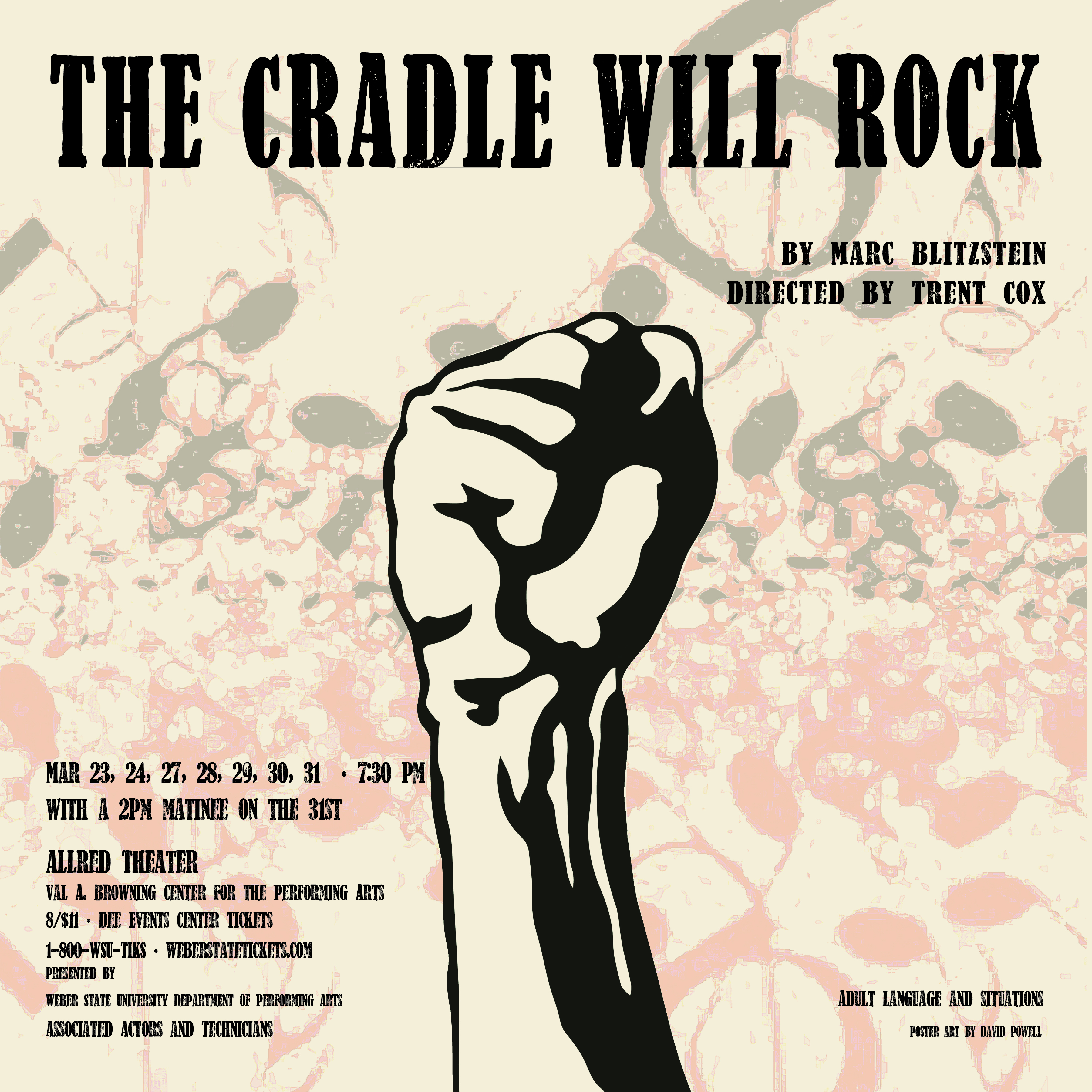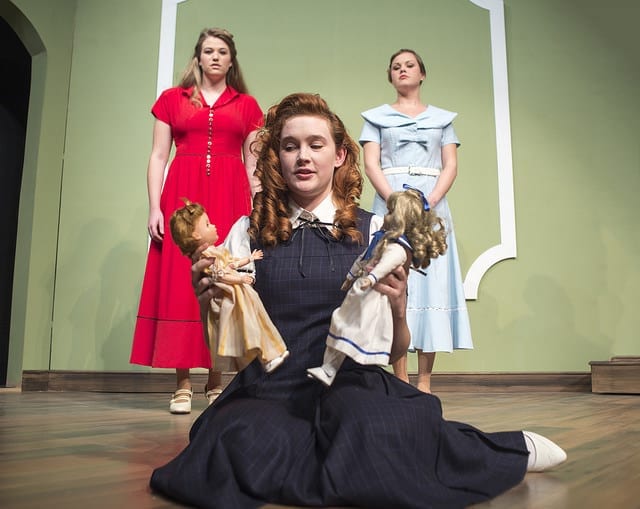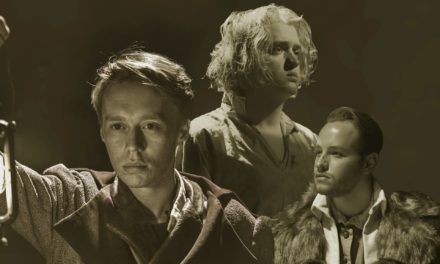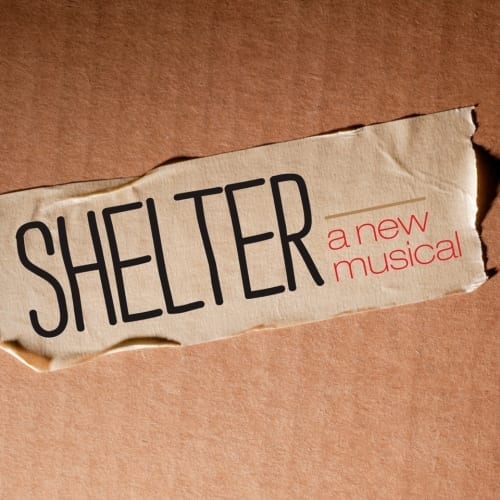OGDEN — “They won’t buy our milk white bodies so we kinda sell out in some other way,” says the pharmacist to the prostitute in a courthouse where several influential people have mistakenly been rounded up as being involved with a union strike. The Cradle Will Rock at Weber State University is about selling out and the corruption and greed that are often found in those who have wealth and power.
With surprising relevance, this 1937 musical draws parallels to modern day struggles. Just as a select few protested wealth inequality, corporate greed and corruption in 1937, less than a year ago a handful of people in NYC began to protest the same ideas in the Occupy Wall Street movement. In fact, this show was so controversial in it’s time that the production was actually shut down. The Cradle Will Rock has an interesting history all detailed out for us on the “leaflets” handed out by union workers before the production began.
Music director Rick Rea accompanied the show on the piano and also served as a narrator at times. During intermission and before the show, he took requests from the audience and I was impressed with his ability to play every request from “Put on a Happy Face” to “Consider Yourself” from Oliver!
The Cradle Will Rock takes a look at the moment in the lives of normal people (the artist, the professor, the reverend, the shopkeeper, etc.) who succumb to the influences of Mr. Mister and his wife. Mr. Mister runs a steel plant that profits because of the war. We see his influence in the university as he enlists young recruits and in the church as Mrs. Mister encourages the reverend to preach. (“Of course it’s peace we’re for – this is war to end all war.”) When the union strikes threaten his overhead, we see his strong-armed tactics come to light. He seems to control nearly every piece of Steeltown, USA. The corruption of Mr. Mister is found in the judicial system, media, churches, schools and business owners.
In an admirable choice, playwright Mark Blitzstein names his characters Cop, Mr. Mister, Reverend, Gent, Polock, etc., thus making them generic enough so we can all see a bit of ourselves in their situations. In the era of Anything Goes and Wizard of Oz, one wouldn’t expect music and political overtones that strike chords with Kander and Ebb (Chicago) and Sondheim some 30+ years before they became famous. With nearly 90% of the show set to music, Blitzstein’s work seems to come long before it’s time which makes it that much more enjoyable and relevant today.
However, despite a great piece to begin with, it’s the choices of the director (Trent Cox) and the solid acting abilities of the cast that really brought this piece to life. A poorly executed script is like getting an email from a friend. It’s nice and the idea is there but when the lighting, set, costume, direction and actors come together, it’s like seeing your friend in person. The lines from being flat words on paper to an experience that is full of expression, depth, and feeling. You can have a dialogue, see things differently and it becomes a relationship. Theater done well creates a relationship between the work and the audience and Cox did this. Every actor had a story and when they were on stage, I could see this uniqueness among all the characters. Mark Nielson (as the Druggist and Jr. Mister) was thorough in his exploration of his characters. His ability to slow down, pause, reflect and move (I loved “Croon” & “Honolulu”) solidified my desire to believe in his story. Nearly every time he spoke, there were moments where you could almost count the seconds between sentences. This allowed for the audience to absorb what he was saying and it was incredibly effective.
The relationship between father and son (Nielson and Christian Johnston) and subsequent ending of scene 5 was extremely touching. The lighting (Austin Hull) and sound really lent to the theatrical quality of what ended up being one of my favorite moments of the night. There was nearly 30 seconds of silence in this scene, and I didn’t take my eyes off the stage. It is often the lack of words that brings a production from good to great.
It’s hard to speak to the vocals of any one individual because they were all strong, clear and beautiful. However, a suggestion would be to mind vocals when on the stairs. Often, the actors would have to look down and up (for safety in climbing the stairs) and vocals would be lost. This was especially noticeable in the sung-though sections. Perhaps an added back railing would help then the actors could focus on projecting outwards.
The set (Tia Byington) and props were simple and artful with paper-mache, soft lighting and an overall feeling of the 1930’s. The tie-in with generic labeling was subtle and appreciated. Costumes (Kelsey Nichols) were appropriate for the time, though Professor Trixie stood out too much for my liking. I understand the choice but it was too much like “which one of these is not like the other?” However, I really loved the use of Professor Mamie’s costume as a chalkboard – that was ingenious!
The visual imagery of the striking fist was well placed and particularly enjoyable as charismatic and angry strike leader Foreman (Addison Welch) rallied the people in “The Cradle Will Rock.” He stirred up emotions by turning the well know lullaby Rock-A-Bye-Baby into an anthem for the protesters. He planned to do this “armed to the teeth…with leaflets.” Here we see the greatest weapon is information and education. It seems this statement held true knowing that the original production was shut down.
The Cradle Will Rock is a beautiful piece of artistic theater. It’s more than a musical with flashy sets and a good story. It’s understated, unassuming, and subtle in its charm. It’s not something that will blow you away, but it is something that will creep up on you, surprise you in it’s talent and delivery and make you wonder just how far we have come over the last 75 years.
[utba_ingo_box]The Cradle Will Rock plays nightly at 7:30 PM thru March 31 and at 2 PM on March 31 at the Eccles Theatre in the Val A. Browning Center for the Performing Arts on the campus of Weber State University. Tickets are $8-11. For more information, visit browningcenter.org.[/box]






